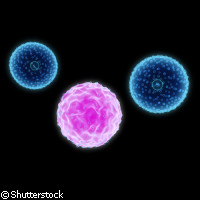Discovery of gene mutation in Down's syndrome-associated leukaemia could lead to new treatment
In an EU-funded study, an international team of researchers has discovered a genetic mutation in people with Down's syndrome who also suffer from acute lymphoblastic leukaemia (ALL), a cancer of the blood or bone marrow. Their discovery, published online in the journal Lancet, could lead to the development of new drugs to treat this severe type of leukaemia. People with Down's syndrome, a disorder caused by an extra copy of chromosome 21, have an increased (10 to 30-fold) risk of developing leukaemia, in particular ALL. This association has been recognised for nearly 70 years, but the cause and underlying mechanisms have not been well understood. As people with Down's syndrome have a higher than normal susceptibility to infection, among other physical abnormalities, designing effective, low-toxicity treatments for these patients has been a major challenge. ALL in Down's syndrome appears to be similar to ALL in other children. Nevertheless, ALL patients with Down's syndrome were in the past often given less aggressive treatments because they showed poor tolerance of classic regimens. Over the years several theories have been put forward to explain the association between Down's syndrome and ALL. Professor Shai Izraeli of the Sheba Medical Centre in Israel and colleagues tested the hypothesis that mutations in JAK2 might be common in Down's syndrome-associated ALL. This particular mutation was a good candidate for study because JAK2 mutations have already been implicated in other white-blood-cell targeting cancers. The researchers analysed bone marrow samples from 87 patients with Down's syndrome-associated ALL. They found that 18% of these patients had JAK2 mutations that were not inherited from their parents (referred to as 'somatic' mutations), and that children who had the JAK2 mutation were diagnosed with ALL earlier (4.5 years) than children without the mutation (8.6 years). The JAK2 mutation comprised alterations in five alleles, each affecting a single amino-acid residue in the protein coded by JAK2's gene, known as R683. The authors concluded that, 'somatically acquired R683 JAK2 mutations define a distinct ALL subgroup that is uniquely associated with Down's syndrome. JAK2 inhibitors could be useful for treatment of this leukaemia.' In his accompanying comment on the JAK2 study, Dr Charles Mulligan of St. Jude's Research Hospital in Tennessee, US, explained that 'ALL is characterised by chromosomal abnormalities, such as gains and losses of whole chromosomes [...] Identification of these abnormalities is important for clinical management, and has provided crucial insights into normal and leukaemic haemopoiesis'. He went on to say that the findings of the current study 'suggest that JAK2 inhibition might be a useful therapeutic approach in JAK2-mutated ALL associated with Down's syndrome'. The discovery of this mutation in Down's syndrome-associated ALL is part of a greater effort to analyse the entire ALL genome. Dr Mulligan cautioned that the results 'represent an important advance in the genetic characterisation of ALL associated with Down's syndrome, but it should be remembered that our understanding of the genomic aberrations needed to induce leukaemia is far from complete.' The feasibility of re-sequencing entire genomes for the treatment of leukaemia and other tumours is the subject of intensive study; it is hoped that in time the entire ALL genome will be uncovered, and that this will lead to the development of novel therapeutic interventions for this disease. The study was led by scientists in Israel, and was carried out by a team of researchers from institutions in Israel, the UK, Italy, Germany, Austria, Czech Republic, Ireland, France and Switzerland. It was supported in part by the European Commission through the Sixth Framework Programme (FP6) integrated project EUROHEAR ('Advances in hearing science: from functional genomics to therapies').
Countries
Austria, Switzerland, Czechia, Germany, France, Ireland, Israel, Italy, United Kingdom



